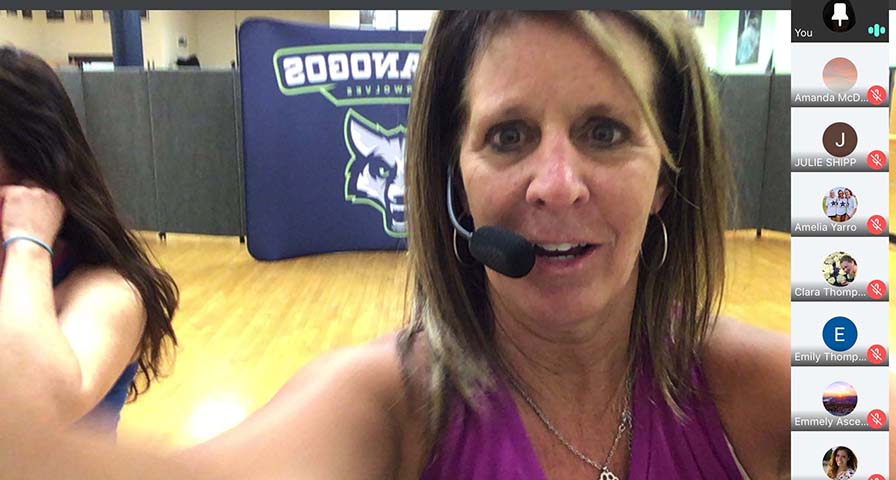With Heart Rate Monitors Locked in School Office, Teacher Uses Online PE to Keep Community Moving
Timpanogos High School (Alpine School District, Utah) teacher Robyn Bretzing’s new online PE classes won’t just keep her students active for the remainder of the school year. Her new classes have proved so popular that she’s extending them into the summer.
“On average there are about 40 people participating in each workout and many have asked if I would consider continuing the workouts during the summer,” Bretzing said.
In early March, Bretzing found herself in the same position as colleagues across the country. The response to the COVID-19 pandemic led to schools closing their physical campuses and transitioning to an online learning model.
“I have never been a huge fan of online PE, but this experience has taught me a lot about myself as an educator,” Bretzing said. “Even when circumstances are not ideal, I can find a way to be creative and still engage my students in purposeful, meaningful activities that help them explore various lifetime fitness activities and improve their personal fitness.”
At the beginning of the school year, Bretzing had introduced technology she felt would help that cause – the IHT ZONE wrist heart rate monitor. Students wear the monitors during her PE classes and receive real-time feedback as they work to improve their fitness.
Students see their actual heart rate as well as a color indicating the heart rate zone that corresponds to their exercise intensity: blue indicates at rest; yellow indicates moderate exertion and red indicates vigorous activity. If Bretzing’s goal for the day requires students to spend the majority of their time exercising in the yellow or red zones, students can see if they are on pace to meet the goal.
Following each class, students get a quick glance at a workout summary on Bretzing’s computer before they receive an email summarizing their workout. The summary email includes a graph tracking the student’s heart rate throughout the session, details how much time the student spent in each heart rate zone and whether the student met Bretzing’s goal for the day. Students can also reflect on the workout by replying to add a journal post.
Adapting to Teaching Online PE
When campuses closed, students no longer had access to that motivating technology. Undeterred, Bretzing developed a two-part strategy to keep her students engaged and moving.
First, she uses her online classroom page – through Canvas – to keep students on task. Bretzing posts regular assignments including a weekly fitness quiz that asks for detail on several key questions:
- What activities did you do today?
- How many minutes did you exercise?
- Compare how you felt on days when you did and did not exercise and share your thoughts.
 Her students’ responses let her know that they are focused on both their physical and emotional health.
Her students’ responses let her know that they are focused on both their physical and emotional health.
“I feel very lazy on the days I don’t exercise and honestly I have a hard time accomplishing anything,” one student wrote. “With online school I find myself sitting a lot and so I look forward to your workouts because it gets me moving!”
When necessary, Bretzing can provide direct feedback as she reviews each response.
Second, using Google’s Hangout Meet tool, she live-streams workouts to continue her teaching and maintain a regular connection.
“I had never thought of broadcasting workouts before nor did I have the technological knowledge to do it,” she said. “This has been a fantastic and fun experience! I love being able to see my students’ faces, chat with them before and after each class, and read the comments they post during the workout.”
Creating Her Own Fitness Phenomenon
A quick study, Bretzing created a series of workouts ranging from High-Intensity Interval Training (HIIT) to Zumba to Yoga. Once she started live-streaming her workouts, she found that her audience had grown beyond her students.
“The workouts have become so popular within our school community that I now have faculty members, parents, administrators, and even district personnel joining in the classes,” Bretzing said.
The broadcasts work for participants of all fitness levels, including students who don’t normally look forward to exercising, especially in a group.
“I have found muscles I never knew I had after doing your workouts,” another student said. “I can’t say my body feels great, but I know I am getting stronger each week and every workout I make it a little bit farther. My goal is to make it through an entire workout without stopping. At first, I wasn’t excited about joining the workouts, but now I look forward to them.”
That feedback, along with a few requests, encouraged Bretzing to keep leading her workouts after school officially ends on May 29.
“Feedback from everyone has been very positive and many students and patrons have expressed the desire to continue the classes until recreation centers and local gyms reopen,” she said. “Why not? I love seeing my school community coming together, getting fit, and having fun! I have committed to teach two mornings a week during this summer and we will see how it goes!”


